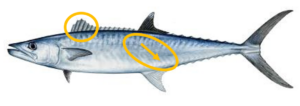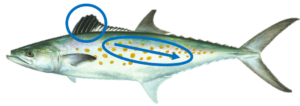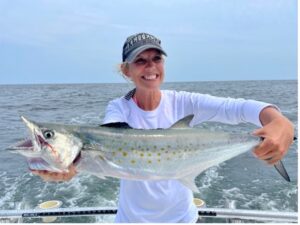
They’re fast, they have sharp teeth, and some of them look alike. It’s easy to tell a mature kingfish from a Spanish or cero mackerel. But, it gets tricky when the kings are juveniles because they could easily pass as a Spanish if you’re not paying close attention. Likewise, cero mackerel have some distinct characteristics that set them apart from Spanish but, if you’re not dialed in, you may not notice. Since the mackerels in the Gulf are subject to different size and possession limits, this guide should help ensure you don’t accidently boat and illegal fish or miss out on one you could have kept.
Wahoo
Wahoo is distinct from the other mackerels in the Gulf for a few reasons. They have the same long, narrow body shape as their cousins but their body is distinctly blue with vertical bands throughout the entire length of their body. Those colors do fade quickly once they’re put on ice so, you’ll also need to pay attention to their jaws which are pointier than the other mackerels with teeth that are smaller and set closer together than kingfish teeth. Also, if you’re paying close attention, the lower jaw or mandible is obscured by skin in a wahoo when the mouth is closed but visible in all its other mackerel cousins.


King mackerel
Kingfish can grow to be quite large and are easily distinguished from Spanish and Cero mackerels once they’re adults. However, as juveniles, kingfish have yellow/gold spots that make them easy to confuse with Spanish and cero mackerel. The two most obvious characteristics that set juvenile kings apart is the sharp drop in their lateral line above the anal fin and the lack of distinct coloration on their first dorsal fin.


Below is a juvenile king mackerel with yellow spots commonly associated with Spanish mackerel and steep lateral line dip that distinguishes it as a kingfish.

Photo courtesy Texas Parks and Wildlife Department: Brenda Bowling
Spanish mackerel
Spanish have silver to greenish bodies with yellow/gold spots. Their first dorsal fin is dark and their lateral like slops gradually along their entire body.


Cero Mackerel
Cero also have silver greenish bodies, yellow/gold spots, a dark dorsal fin, and gently sloping lateral line. However, they also have a distinct yellow line running the length of their body and their yellow spots are a bit more organized and linear than those of the Spanish mackerel.


Photo: David Parra courtesy of Fish Rules
Knowing how to identify the different mackerels will help ensure that you don’t cheat yourself of of an extra fish. It’ll also help you avoid accidentally harvesting in inappropriate fish. Now that you can tell them apart, find detailed commercial and recreational regulations on the Fish Rules Mobile App.
